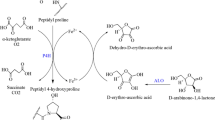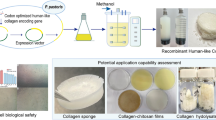Abstract
Human-like collagen (HLC) is a novel biomedical material with promising applications. Usually, insoluble HLC was formed due to over-expression. In order to improve the production of soluble HLC, the effective chaperone proteins and their mediation roles on HLC were clarified. Trigger factor (TF) pathway with low specificity and high binding affinity to nascent chains could increase soluble HLC expression; GroEL-GroES could increase the expression level of HLC by assisting the correct folding of HLC and increase mRNA level of the gene coding for HLC by enhancing mRNA stability. DnaK chaperone system did not work positively on soluble HLC due to the unbalanced ratio of DnaK:DnaJ:GrpE, especially too high GrpE significantly inhibited DnaK-mediated refolding. The production of soluble HLC with co-expression of exogenous TF and GroEL-GroES was increased by 35.3 % in comparison with the highest value 0.26 g/L reported previously.





Similar content being viewed by others
References
Bhandari P, Gowrishankar J (1997) An Escherichia coli host strain useful for efficient overproduction of cloned gene products with NaCl as the inducer. J Bacteriol 179:4403–4406
Friess W (1998) Collagen-biomaterial for drug delivery. Eur J Pharm Biopharm 45:113–136
Pati F, Adhikari B, Dhara S (2010) Isolation and characterization of fish scale collagen of higher thermal stability. Bioresour Technol 101:3737–3742
Fan DD, Luo YE, Mi Y, Ma XX, Shang LA (2005) Characteristics of fed-batch cultures of recombinant Escherichia coli containing human-like collagen cDNA at different specific growth rates. Biotechnol Lett 27:865–870
Smirnova GV, Oktiabr’skiĭ ON (1985) Effect of acetate on the growth of Escherichia coli during aerobiosis and anaerobiosis. Mikrobiologiia 54:252–256
Zhu CH, Fan DD, Duan ZG, Xue WJ, Shang LA, Chen FL, Luo YE (2009) Initial investigation of novel human-like collagen/chitosan scaffold for vascular tissue engineering. J Biomed Mater Res A 89:829–840
Wang Y, Cui FZ, Zhai Y, Wang XM, Kong XD, Fan DD (2006) Investigations of the initial stage of recombinant human-like collagen mineralization. Mat Sci Eng C Mater 26:635–638
Zabriskie DW, Wareheim DA, Polansky MJ (1987) Effects of fermentation feeding strategies prior to induction of expression of a recombinant malaria antigen in Escherichia coli. J Ind Microbiol 2:87–95
Sahdev S, Khattar SK, Saini KS (2008) Production of active eukaryotic proteins through bacterial expression systems: a review of the existing biotechnology strategies. Mol Cell Biochem 307:249–264
Nishihara K (1998) Chaperone Coexpression plasmids: differential and synergistic roles of DnaK-DnaJ-GrpE and GroEL-GroES in assisting folding of an allergen of Japanese cedar pollen, Cryj2, in Escherichia coli. Appl Environ Microbiol 64:1694–1699
Hartl FU, Hayer-Hartl M (2002) Molecular chaperones in the cytosol: from nascent chain to folded protein. Science 295:1852–1858
Cui SS, Lin XZ, Shen JH (2011) Effects of co-expression of molecular chaperones on heterologous soluble expression of the cold-active lipase Lip-948. Protein Expres Purif 77:166–172
Makrides SC (1996) Strategies for achieving high-level expression of genes in Escherichia coli. Microbiol Mol Biol R 60:512–538
Rehdorf J, Kirschner A, Bornscheuer UT (2007) Cloning, expression and characterization of a Baeyer-Villiger monooxygenase from Pseudomonas putida KT2440. Biotechnol Lett 29:1393–1398
Fan DD, Duan MR, Mi Y, Song JR, Xi JF, Wang DW, Wang GZ (2002) High density fermentation of recombinant E. coli for production of human-like collagen. J Chem Ind Eng 53:752–754 (In Chinese)
Nishihara K, Kanemori M, Yanagi H, Yura T (2000) Overexpression of trigger factor prevents aggregation of recombinant proteins in Escherichia coli. Appl Environ Microbiol 66:884–889
Guo L, Luo YE, Fan DD, Xu R, Hui JF, Ma XX, Zhu CH (2012) Improved productivity of recombinant human-like collagen II by supplying amino acids encoded by rare codons. Afr J Microbiol Res 6:3856–3865
Korz DJ, Rinas U, Hellmuth K, Sander EA, Deckwer WD (1995) Simple fed-batch technique for high cell density cultivation of Escherichia coli. Biotechnol 39:59–65
Yin MW, Nan YM, Wang XM (1994) Improvement of the spectrophotometric method for the determination of hydroxyproline. J Henan Med Univ 29:74–77
Qiagen, The QIA expressionist (2001) A handbook for high-level expression and purification of 6xHis-tagged proteins. 3rd edn. Hilden, Germany, pp 79–80
Schmittgen TD, Livak KJ (2008) Analyzing real-time PCR data by the comparative CT method. Nat Protoc 3:1101–1108
Blum P, Ory J, Bauernfeind J, Krska J (1992) Physiological consequence of DnaK and DnaJ overproduction in Escherichia coli. J Bacteriol 174:7436–7444
Guo JQ, Luo YE, Fan DD, Gao PF, Ma XX, Zhu CH (2010) Analysis of metabolic products by response surface methodology for production of human-like collagen II. Biotechnol Appl Biochem 18:830–836
Mogk A, Tomoyasu T, Goloubinoff P, Rudigerm S, Roder D, Langen H, Bukau B (1999) Identification of thermo labile Escherichia coli proteins: prevention and reversion of aggregation by DnaK and ClpB. EMBO J 18:6934–6949
Robin S, Togashi DM, Ryder AG, Wall JG (2009) Trigger Factor from the psychrophilic bacterium psychrobacter frigidicola is a monomeric chaperone. J Bacteriol 191:1162–1168
Teter SA, Houry WA, Ang D, Tradler T, Rockabrand D, Fischer G, Blum P, Georgopoulos C, Hartl FU (1999) Polypeptide flux through bacterial Hsp70: DnaK cooperates with trigger factor in chaperoning nascent chains. Cell 97:755–765
Ferbitz L, Maier T, Patzelt H, Bukau B, Deuerling E, Ban N (2004) Trigger factor in complex with the ribosome forms a molecular cradle for nascent proteins. Nature 431:590–596
Schiene-Fischer C, Habazettl J, Schmid FX, Fischer G (2002) The hsp70 chaperone DnaK is a secondary amide peptide bond cis-trans isomerase. Nat Struct Biol 9:419–424
Hyunjin Y, Hong JY, Ryu S (2008) Effects of chaperones on mRNA stability and gene expression in Escherichia coli. J Microbiol Biotechnol 18:228–233
Endo S, Tomimoto Y, Shimizu H, Taniguchi Y, Onizuka T (2006) Effects of E. coli chaperones on the solubility of human receptors in an in vitro expression system. Mol Biotechnol 33:199–209
Patzelt H, Rudiger S, Brehmer D, Kramer G, Vorderwulbecke S, Schaffitzel E, Waitz A, Hesterkamp T, Dong L, Schneider-Mergener J, Bukau B, Deuerling E (2001) Binding specificity of Escherichia coli trigger factor. Proc Natl Acad Sci USA 98:14244–14249
Fenton WA, Horwich AL (2003) Chaperonin-mediated protein folding: fate of substrate polypeptide. Q Rev Biophys 36:229–256
Hartl FU, Bracher A, Hayer-Hartl M (2011) Molecular chaperones in protein folding and proteostasis. Nature 475:324–332
Deuerling E, Schulze-Specking A, Tomoyasu T, Mogk A, Bukau B (1999) Trigger factor and DnaK cooperate in folding of newly synthesized proteins. Nature 400:693–696
Calloni G, Chen TT, Schermann SM, Chang HC, Genevaux P, Agostini F, Tartaglia GG, Hayer-Hartl M, Hartl FU (2012) DnaK functions as a central hub in the E. coli chaperone network. Cell Rep 1:251–264
Caplan AJ, Cyr DM, Douglas MG (1993) Eukaryotic homologues of Escherichia coli DnaJ: a diverse protein family that functions with hsp70 stress proteins. Mol Biol Cell 4:555–563
Pierpaoli EV, Sandmeier E, Schönfeld HJ, Christen P (1998) Control of the DnaK chaperone cycle by substoichiometric concentrations of the co-chaperones DnaJ and GrpE. J Biol Chem 273:6643–6649
Szabo A, Langer T, Schröder H, Flanagan J, Bukau B, Hartl FU (1994) The ATP hydrolysis-dependent reaction cycle of the Escherichia coli Hsp70 system-DnaK, DnaJ and GrpE. Proc Natl Acad Sci USA 91:10345–10349
Tilly K, McKittrick N, Zylicz M, Georgopoulos C (1983) The DnaK protein modulates the heat shock response of Escherichia coli. Cell 34:641–646
Grimshaw JP, Siegenthaler RK, Züger S, Schönfeld HJ, Z’graggen BR, Christen P (2005) The heat-sensitive Escherichia coli grpE280 phenotype: impaired interaction of GrpE (G122D) with DnaK. J Mol Biol 353:888–896
Sugimoto S, Saruwatari K, Higashi C, Sonomoto K (2008) The proper ratio of GrpE to DnaK is important for protein quality control by the DnaK-DnaJ-GrpE chaperone system and for cell division. Microbiol 154:1876–1885
Georgellis D, Sohlberg B, Hartl FU, von Gabin A (1995) Identification of GroEL as a constituent of an mRNA-protection complex in Escherichia coli. Mol Microbiol 16:1259–1268
Bouvet P, Belasco JG (1992) Control of RNase E-mediated RNA degradation by 5′-terminal base pairing in E. coli. Nature 360:488–491
Acknowledgments
This study was financially supported by the National Natural Science Foundation of China [21176200]; the Scientific Research Program of Shaanxi Provincial Department of Education, China [2010JC21]; and Shaanxi Biochemical Engineering Key Discipline Program, China.
Author information
Authors and Affiliations
Corresponding author
Rights and permissions
About this article
Cite this article
Jia, Q., Luo, Y. The selective roles of chaperone systems on over-expression of human-like collagen in recombinant Escherichia coli . J Ind Microbiol Biotechnol 41, 1667–1675 (2014). https://doi.org/10.1007/s10295-014-1500-x
Received:
Accepted:
Published:
Issue Date:
DOI: https://doi.org/10.1007/s10295-014-1500-x




